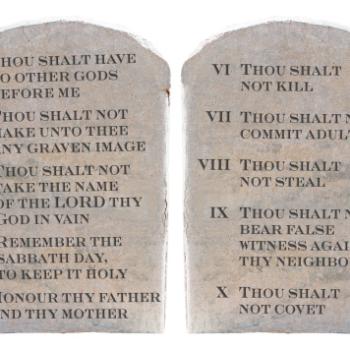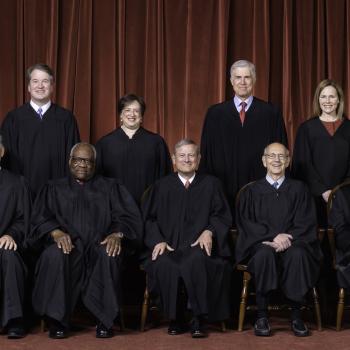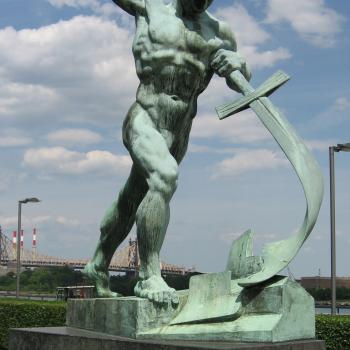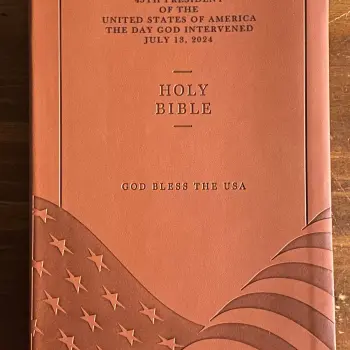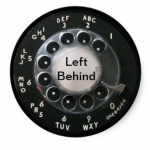I believe the Jews had a right to return to the land of Israel and settle there. It was the proper and just way to settle the so-called “Jewish Problem.” What’s that? The Romans threw Jews out of their land, and they dispersed throughout much of the world, called The Diaspora. There, in Gentile lands, they endured much unjust persecution and thus suffering. The worst was the Nazi Holocaust in WWII. That demonstrated that Jews should be able to return to their ancestral land.
But I also believe indigenous Arabs who lived there in so-called Palestine prior to this Jewish settlement had a right to live there as well. But since modern Israel was established in 1948-49, the result has been a Palestinian Problem sometimes comparable to the Jewish Problem, although not as severe.
Let me ask you a question. If you owned a house and its land where there were no laws, and someone attacked you, took your property, and you had to escape with your life, how would you feel about it? With no recourse to law, what you would do about? That’s what happened to many Palestinians–twice. Who did it? The Jews. Yes, it involved the Jews being attacked first by others as well. But shouldn’t the Jews have to return any property they took from its former owners?
The UN passed a resolution in late 1947 which called for two states to be established in “Palestine:” one for Jews and the other for Arabs, who soon became known as “Palestinians.” The U.S. was now in an isolation mode due to exhaustion from WWII. Thus, the U.S. Congress rebuffed the Soviet Union’s suggestion for it and the U.S. to jointly implement this UN resolution. And the Soviet Union had lost far more people than the U.S. did during WWII.
When the British withdrew from their Palestine Mandate obligation, as they said they would do on May 15, 1948, the result was war between Jews, Arabs, and surrounding Arab states somewhat. At the end of that war, eighteen months later, the Jews had achieved their state, and the Palestinians were still wanting. And that’s what they have wanted ever since to this day–their own, sovereign, independent state.
Where was the new Jewish state? It was located in land between the Mediterranean Sea and the Jordan River-Dead Sea Depression, with a huge chunk therein still possessed by the Arabs. This piece of land came to be called “the West Bank” because its eastern border was the Jordan River-Dead Sea, thus the west bank of the Jordan River. The rest of its boundary the UN called “the Green Line” due to the peace armistice. This West Bank area was amazingly the same area as Samaria and Judea in antiquity. That is why Israeli Jewish politicians ever since have often referred to it as “Judea and Samaria” rather than “the West Bank,” as the Palestinians do, the UN does, and thus the international community does.
Back at midnight on May 15, 1948, Jews leaders had drafted and published a three-page document entitled Israel’s “Proclamation of Independence” (which was based on the Brits’ Balfour Declaration of 1917). This Proclamation repeatedly demands the right of Jews to establish a state in “Eretz Yisrael” (Hebrew for “Land of Israel), in the Jews’ “ancestral land.” But where is that located? The document doesn’t say, and Israeli Jewish politicians have always avoided defining “ancestral land” in that document. Why? Doing so opens a can of worms.
When the war ended in 1949, Jews had possession of territory outside the Green Line-Jordan Depression, that is, outside of the West Bank, and the Arabs had possession of the West Bank and a tiny strip of land on the coast called “the Gaza Strip.” This territory that Jews possessed then became known as the State of Israel. But that territory was not what the Jews had demanded in their Proclamation of Independence. In fact, it was largely the opposite. The West Bank, being Judea and Samaria, was the heartland of ancient Israel and thus the Jews’ ancestral land, and they didn’t have any of it.
So, modern Israel has comprised about half of the Jews’ ancestral land, with much of Israel being located in “the land of the Philistines,” a people from whom the word “Palestine” derives. Ancient Philistia, the arch rival of ancient Israel, was located in the coastal plain. Exactly where? Although borders of both ancient Israel and Philistia were somewhat fluid throughout their history, much of the time Philistia extended in a north-south direction from just north of Joppa (Tel Aviv) to the Wadi el Arish in present Sinai. However, most of the time in later centuries it began in the north a few miles south of Joppa, usually at the brook Nahal Sorek. It’s eastern border was usually the Shephelah and southward to the western environs of Beersheba and Kadesh Barnea.
A good way to think of ancient Philistia is to think of its main cities, which were five in number: Ashdod, Ashkelon, Gaza, Ekron, and Gath. Ashdod and Ashkelon are cities in modern Israel, thus that land is ancient Philistine land. The same goes for Ekron and Gath, which were located in the northwestern corner of Philistia.
Back to the review of this Israeli-Palestinian conflict, in October, 1967, Israel fought the Six-Day War and gained possession of four territories: West Bank, Golan Heights, Gaza Strip, and Sinai Peninsula. According to bylaws of the UN, of which Israel is a member, these are called “occupied territories.” And also according to those bylaws, Israel is required to return those lands to their former owners. It did so with the Sinai Peninsula in 1979, and in 2005 it disengaged from the Gaza Strip, effectively turning it over to the Palestinians.
For over a generation now, the U.S. has been the peace broker trying to resolve this Israeli-Palestinian conflict. But all that has happened is that this conflict has gotten worse. Although it can be argued that returning the Sinai made things better, that cost Egypt’s great statesman President Anwar Sadat his life when he was assassinated for making this agreement with Israel. And the other Arab states who fought in this war then marginalized Egypt in the Arab world. Then there were two Palestinian uprisings, called intifadas. In 1987, the PLO announced that it no longer advocated violence to achieve its desired Palestinian state. After that, Israel allowed the Palestinian organization Fatah to rule Palestinian life in the West Bank under many restrictions.
But that same year the Islamic Hamas, an offshoot of the Muslim Brotherhood, was founded in the Gaza Strip. At first, it was only a social organization, but it soon developed a military wing to conduct armed hostilities against Israel. And Palestinian organization Islamic Jihad, which has always been more militant than Hamas, was founded back in 1979. All of this increase in Palestinian hostility toward Israel happened because nothing was being accomplished in resolving this Israeli-Palestinian conflict.
But it was useless for Israel to continue its possession, and thus control, of the Gaza Strip. It had tried Jewish settlements there, but that wasn’t doing well since they needed protection among a very Palestinian population. So, in 2005 Israel required the settlers there to leave, voluntarily demolished those settlements, withdrew its armed forces, and effectively turned control, and thus ownership, of the Gaza Strip over to the Palestinians.
As the Bush administration desired, the Palestinian Authority held free elections later in 2006 in both the West Bank and Gaza Strip for the 120 seats in its parliament. Prior to this, Hamas had always refused to participate in the Palestinian political process. But this time it did. The result was an upset victory for Hamas, which gained a majority of the seats in parliament and almost twice as many as Fatah won. The U.S. policy had backfired dramatically, since he did not want Hamas winning. The U.S. then refused to recognize the results of the election and placed Hamas on its infamous terrorist list. Isn’t that hypocritical of the U.S.?
The next year, in 2007, Fatah and Hamas militarily fought battles in the Gaza Strip, and Hamas emerged the victor. Hamas has governed the Gaza Strip ever since. And Fatah and Hamas have been split as enemies. The U.S. and Israel thereafter undertook policies to further divide Fatah and Hamas. This result means that since then no Palestinian organization really represented the Palestinians in the peace process, which was revived by U.S. Secretary of State John Kerry last year.
Then this week Fatah and Hamas announced they had achieved a reconciliation agreement which provides that they would form a unity government within five weeks. Israel then announced its withdrawal from the peace process, which Secretary Kerry worked so hard on for the past nine months. But it was going to be dead anyway if the Fatah-Hamas agreement results in a unity government. The U.S. will not involve itself with Hamas since it remains on the U.S. terrorist list.
I’m reading a book by Harvard scholar and authority of the Palestinians plight in Gaza Strip Sara Roy entitled Hamas and Civil Society in Gaza: Engaging the Islamist Social Sector (2011, Princeton U. Press). She says that despite the Hamas Charter, which calls for the destruction of Israel and retaking of all of “Palestine,” Hamas is susceptible to change these declarations. She says, “there can be no credible peace process with a Palestinian government that excludes the party elected by Palestinians to govern them,” referring to Hamas. She continues, “Hamas not only remains open to sharing power; it also has a history of nonviolent accommodation and political adaptation, ideological reflexivity and transformation, and political pragmatism that the West should welcome. The alternative portends disaster, as it threatens to strengthen the more regressive elements within Hamas and radicalize Palestinians overall, further destabilizing a situation that is already fraught with unbearable tension” (pp. 48-49).
So, in my opinion, U.S. efforts to solve the Israeli-Palestinian conflict look like a disaster. But I have to admit that if the U.S. had pulled out long ago as the peace broker for this ongoing, intractable situation, it might have gotten worse. But then, maybe Europe would have gotten its act together, which seems a pipe-dream, and become more involved. Nevertheless, there are some who are saying that Palestinians being represented by a unified Fatah and Hamas might lead to a settlement of this conflict.
For me, it won’t be successfully solved with the focus continuing on a piece of Swiss-cheese West Bank and separated territory of the Gaza Strip in which to establish a Palestinian state. If it happens, it won’t work. The focus on land should change. It has happened because that’s the way the land was settled. in modern times. The U.S. has always refused to seriously challenge Israel about its continued settlement policy in the West Bank, which constantly derails the peace process because of the Palestinian vision of its state being mostly in the West Bank.
Recently, Palestinian President Mahmoud Abbas has said he might resign and the Palestinian Authority collapse. Life for many Palestinians in the West Bank has become intolerable largely due to the West Bank Security Barrier. And life is pretty intolerable for all Palestinians in the Gaza Strip due to Israel hemming its people in with a fence, stations, much restrictions on imports, etc.
I say settle the conflict according to historical precedent. That’s what Israel’s Proclamation of Independence demands for Jews. So, let the Jews have all of their ancestral land, which includes the West Bank, and let the Palestinians have all of the land of the Philistines. Yes, that requires a serious transfer of peoples, which will be costly. But then, it would truly be “two states lying side-by-side,” which is not what the ongoing focus has been even though many diplomats and politicians. That will provide better security for both peoples. And the Palestinians could then claim rights to what probably will prove to be very lucrative offshore Mediterranean oil and gas deposits. Palestinians could also barter, trading oil/gas for water with Egypt and Nile riparian nations to get some Nile water transported through the Al-Salam Canal to this State of Palestine. And I think those Palestinians who claim a “right of return” to their former homelands in Israel would prefer this arrangement in what would be a much more prosperous State of Palestine than a Swiss-cheese West Bank-Gaza entity with a necessary corridor connecting the two parcels. That would solve the problem of right-of-return, which Israel now calls a rejection of Israel as a Jewish state.
(To learn more about this proposal for solving the Israeli-Palestinian conflict, and why I adopt it, read my book Palestine Is Coming: The Revival of Ancient Philistia and learn about it at kermitzarley.com. This book is more relevant to the situation now than when it was published, in 1990.)



